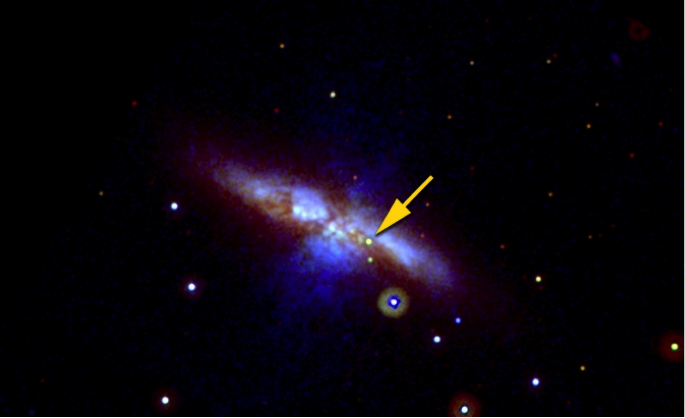Radioactive emission from type Ia supernovae
The amount and distribution of radioactive isotopes produced in thermonuclear supernovae, SNIa and the different subtypes, strongly depend on the stellar configuration at the onset of the explosion, on the ignition process and on the propagation mode of the flame. This means that the gamma rays produced by these isotopes can be used as a diagnostic tool for the explosion. The most interesting gamma-ray lines are those produced by the decay of 56Ni and its daughter isotope 56Co, including the annihilation line at 511 keV.
Required instrument performances:
Lines are very broad, from 5 to 10% and the Ni ones display an important time dependence. Since SN explosions cannot be predicted, the instrument has to be able to study in detail the nearby ones, < 20 Mpc, and to provide the gross features of the most distant.
 Swift UVOT image taken on Jan. 22, 2014 showing the type Ia SN 2014J in the nearby galaxy M82. Credit: NASA/Swift/P. Brown, TAMU |
Required instrument performances:
Lines are very broad, from 5 to 10% and the Ni ones display an important time dependence. Since SN explosions cannot be predicted, the instrument has to be able to study in detail the nearby ones, < 20 Mpc, and to provide the gross features of the most distant.
| Performance parameter | Goal value | Remarks and notes |
|
Field-of-view (FWHM, deg) |
||
|
Angular resolution (FWHM, deg) |
||
|
Spectral resolution (ΔE/E @ Energy) |
~0.003 |
In case of nearby supernovae Lines are broad ~ 20-40 keV |
|
Line sensitivity (@ Energy) (cm-2 s-1, 3σ, 1 Ms) |
||
|
Continuum sensitivity (in which energy band?) (cm-2 s-1 keV-1, ΔE=E, 3σ, 1 Ms) |
~ 10-7 |
To detect a significant number of SNIa/year Range 0.1 to 2 MeV |
| Timing performances |
|
|
|
Polarimetric capability (Minimum Polarization Fraction for a Crab source in 1 Ms) |
|
|
| Real-time data? |
 AstroMeV
AstroMeV